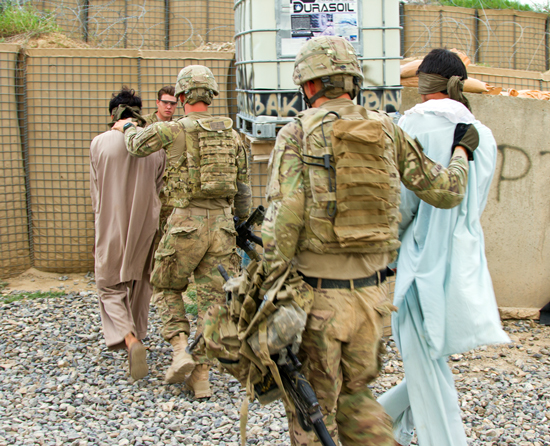
A little over a week ago, I was waiting for a helicopter at Combat Outpost (COP) Sabari’s landing zone with a pair of special fellow travelers: two detainees snapped up during a recent patrol north of the base. One of the men had been fingered by captured insurgents as an alleged “Taliban financier,” an ostensible rainmaker who travels to the rich Arab states to rattle his cup for violent jihad in Afghanistan. The other man had merely been present in the other suspect’s house when the Americans knocked on the door, and he will presumably be released unless additional evidence indicts him for a longer stay.
The delicate manner in which the blindfolded detainees were treated – even before the soldiers seemed to realize there was a reporter around – was pretty striking, and indicates that upper echelons of the command structure have inculcated the lessons of Abu Ghraib into Army culture. The suspects were proactively given plenty of water, and when a few drops of rain began to patter the ground, the soldiers protectively shepherded the Afghans into the shelter of the indirect fire bunker, carefully shielding their heads before gently seating them on the ground. Despite the kid gloves, one detainee was so frightened that he shook and occasionally vomited (“third time today,” according to one American), whereas the other fellow remained calm.
The sky began to precipitate metal a few minutes later, so we all joined them. Two mortars landed nearby, and roughly a dozen US soldiers and civilians crowded into one of the hot little concrete sarcophagi that insulate men from random clouds of shrapnel. I wound up next to a detainee (mercifully, not the one who was vomiting). Embed rules forbade me from interacting with the man, but I watched as he squatted while absentmindedly chewing on his plastic cuffs, or oddly rubbing their dangling straps across his face. He also made periodic sneak attempts to lift his blindfold — just enough to see out underneath it. One of his American minders would inevitably notice, sigh, and replace the cloth over the Afghan’s eyes, admonishing him to “stop doing that.”
“We’re not allowed to put the sacks over their heads anymore,” a soldier explained. “It was easier.”
The US soldiers then had a conversation amongst themselves about the various scandals in Iraq and Afghanistan that had probably influenced the extra-careful detainee handling procedures. The general consensus: those men who had stained the Army’s reputation must have been from poorly trained and led units.
“You know that guy speaks English, right?” warned one man at some point in the conversation, as he motioned to the calm detainee.
“Hey, this guy’s homeboys out there are trying to blow us up,” joked another American a minute later, perhaps five minutes after the last exploding mortar.
I’m not sure whether it was due to nerves or satisfaction about the sentiment, but the detainee laughed.
Are you a dedicated reader of FDD's Long War Journal? Has our research benefitted you or your team over the years? Support our independent reporting and analysis today by considering a one-time or monthly donation. Thanks for reading! You can make a tax-deductible donation here.








7 Comments
Yeah, or perhaps his homeboys were trying to kill the detainee before he squeals on them.
An informative and insightful report.
It would be interesting to know if the decision to cuff the detainees’ hands in front is a local option; driven by other practical considerations, such as a need to enable them to communicate with gestures; or is simply a system-wide policy choice.
From a tactical perspective, it historically leaves a lot to be desired. Suspects that are even handcuffed in the rear can and do nonetheless fight ferociously and effectively.
Mr Ardolino,
Good article. Will this make it out into the “mainstream media”? It would be great to remind our public of the professionalism of our troops and the fact that our enemies are treated quite a bit better by us than we tend to be by them.
Having spent a considerable amount of time at Sabari DC, I read these reports with interest, and would love to go back there. At the time (MAR08-APR09) we considered it the worst place in the world. Helmand and Pech were getting more media, but Sabari, Bak, Maqtab, Kholbesat, Zambar, 4 Corners…. very bad places that maimed or killed a good number of our guys.
@Ken North- flexcuff detainee in front helps to get them in helicopters and strapped down faster. We used blacked out goggles and earmuffs to keep them insulated. (One detainee, in safekeeping by our ANP partners on ANP side of base at Sabari, had his cuffs taken off so he could eat. This is same guy who had fired at ANP before we grabbed him. Different culture…
KGH: Thanks for the clarification and, more importantly, for your service down-range.
Helicopters hadn’t been invented yet when I was first using cuffs . . .
So PC…Amend ROE…Let’s fight this thing like we are in it to Win it…
Like a mouse eating cheese – one or two of the Cats at a time.